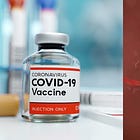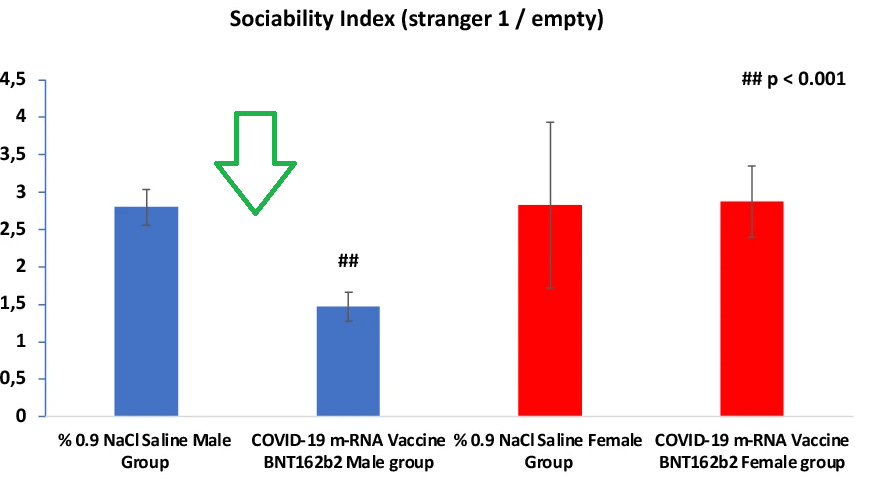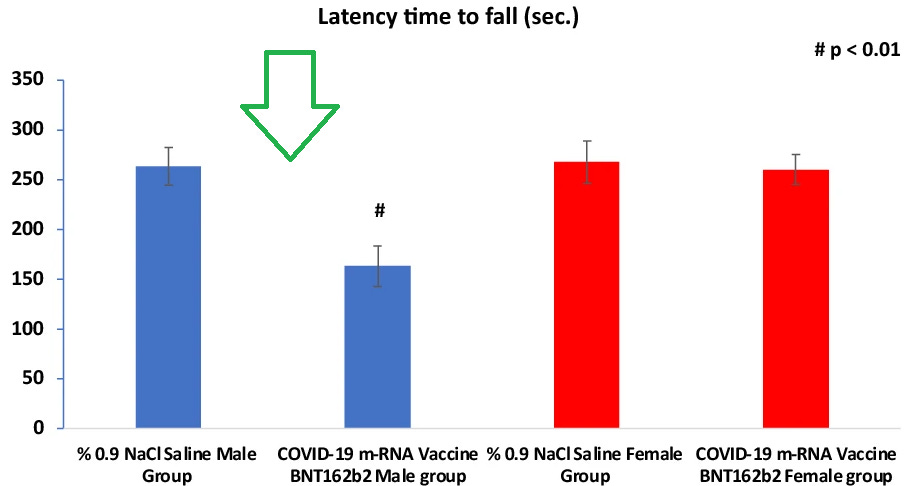New Study: 'Prenatal Exposure to COVID-19 mRNA Vaccine BNT162b2 Induces Autism-Like Behaviors in Male Neonatal Rats'
Preclinical study that wasn't done when we warped the speed of science to skip all the science parts
A new study with an eye-opening title just dropped from Turkey:
“Prenatal Exposure to COVID-19 mRNA Vaccine BNT162b2 Induces Autism-Like Behaviors in Male Neonatal Rats: Insights into WNT and BDNF Signaling Perturbations”
https://pubmed.ncbi.nlm.nih.gov/38198049/
I suppose it was only a matter of time before we finally got a study potentially linking autism to the mRNA jabs.
The potential significance of such findings speak for themselves.
For some reason, Turkey seems to be uniquely willing to do the sort of blunt studies that are persona non grata in Western academia.
Also, the name of the study’s lead author is Erdogan:
Short Summary
The study found significant differences between rats born to mothers vaccinated during pregnancy versus a control group of rats born to unvaccinated mothers in the following areas:
Motor coordination & balance (males)
Social behavior (males)
Quantity of Purkinje cells and other neural cells (males)
Brain-derived neurotrophic factor (BDNF) protein levels (males & females)
Long Version
The objective and design of a study determines the nature of your results - you won’t find what you don’t look for. This study immediately stands out for its straightforward and honest inquiry to determine if the Pfizer vaccine might be affecting the neurodevelopment during gestation in rats vaccinated during pregnancy:
“This study aimed to investigate the gene expression of WNT, brain-derived neurotrophic factor (BDNF) levels, specific cytokines, m-TOR expression, neuropathology, and autism-related neurobehavioral outcomes in a rat model.”
There’s a Talmudic aphorism, “the question of a wise man is half the answer.” Ask good questions, get good results:
“Our findings reveal that the mRNA BNT162b2 vaccine significantly alters WNT gene expression and BDNF levels in both male and female rats, suggesting a profound impact on key neurodevelopmental pathways.
Notably, male rats exhibited pronounced autism-like behaviors, characterized by a marked reduction in social interaction and repetitive patterns of behavior.
Furthermore, there was a substantial decrease in neuronal counts in critical brain regions, indicating potential neurodegeneration or altered neurodevelopment.
Male rats also demonstrated impaired motor performance, evidenced by reduced coordination and agility.”
There are a number of fascinating details to unpack here. (For the academically adventurous, this study is written with an organized structure and in accessible English.)
Behavioral / Clinical differences
The study performed four behavioral tests, of which #’s 1 & 4 showed meaningful differences between the vaccinated and unvaccinated male rats:
1) ‘Three-Chamber Sociability and Social Novelty Test’
This test gauged the rats’ inclination to socialize. It is a bit long-winded to explain in detail, but the basic setup is that each rat was placed between two chambers, one with a ‘stranger’ rat and the other either without any rat or with a ‘familiar’ rat, with the amount of time the rat spent in each as the measured variable.
2) ‘Open Field Test’
Rats were placed in a closed enclosure for five minutes and monitored to see how much it wandered around or explored.
3) ‘Novelty-Induced Rearing Behavior’
Similar to the open field test, rats were placed in a transparent cage they had never been placed in before (a “novel” experience for the rats) and monitored to see how many times “the creature stood erect on its hind limbs, leaned against the enclosure walls using its forelimbs, or a combination of both”.
4) ‘Rotarod test’
This is a standard test used to assess physical coordination of rats and mice:
Significant Behavioral Differences
Vaccinated male rats were significantly less sociable than unvaccinated male rats or both vaccinated and unvaccinated female rats:
In the Rotarod test, they observed that the vaccinated male rats performed significantly worse - i.e. they were unable to maintain their balance on the wheel as long - compared to both the unvaccinated male rats and the vaccinated female rats.
As described by the study, “motor performance was significantly affected in a sex-dependent manner in the vaccinated group.”
Histological Differences
Unlike the behavioral tests, the study documented significant differences in vaccinated female rats for some of the histological parameters they looked at.
Brain-derived neurotrophic factor (BDNF) levels
BDNF is a protein that “plays an important role in neuronal survival and growth, serves as a neurotransmitter modulator, and participates in neuronal plasticity, which is essential for learning and memory.”
The study found that levels of BDNF were significantly lower (seen by the large discrepancy between the numerical measurements) in both the male and female vaccinated rats compared to the unvaccinated rats:
Quantity of neural cells
Purkinje cells “have a vital role in motor movement and coordination, spatial memory and learning, and even certain cognitive behavior.”
The authors observed a significant decrease in the quantity of neuronal counts and Purkinje cells (a type of nervous cell) in vaccinates male rats but not female rats:
This fits with the observed differences in motor coordination of the vaccinated male rats but not the vaccinated female rats.
They also found “dysmorphological changes” - i.e. abnormalities - in the tissues of the brain regions they sampled for counting these neural cells in the vaccinated male rats but not the vaccinated female rats.
Gene expression
m-TOR is a gene that encodes for the m-TOR protein, which “coordinates eukaryotic cell growth and metabolism with environmental inputs including nutrients and growth factors”.
WNT is a gene that encodes for the WNT protein, which are “secreted, lipid-modified glycoproteins that allow for communication between cells. They regulate cell growth, function, differentiation, and cell death. WNT proteins play a central role in bone development, modeling, and remodeling.”
Quantification of gene expression is overly wonky and technical, so we’ll just present the topline results.
In vaccinated male rats, in one of the methods they used to quantify gene expression, they observed a significant increase in the expression of the m-TOR gene and a significant decrease in the expression of the WNT gene compared to unvaccinated male rats.
In vaccinated female rats, in one of the methods they used to quantify gene expression, they observed a significant decrease in expression of the WNT gene. They also observed a non-significant increase in expression of the m-TOR gene for the vaccinated female rats.
Significance of the findings
You don’t need to be a rocket scientist to appreciate that significant differences in behavior or in the expression of critical genes in fetal development can manifest as or indicate significant clinical conditions. It is equally obvious that this study - and others like it - are a clarion call for further *honest and open* research into these issues, even - especially - for people who still believe in the mainstream narrative about the covid vaccines.
The authors do provide us with a more in-depth explanation of what their findings might portend, written in fairly readable English:
The COVID-19 mRNA vaccine seems to induce autism-like behaviors in male rats, impacting the WNT and BDNF pathways in both genders [2]. This gender-specific outcome emphasizes questions on the vaccine’s influence on brain function and structure. There’s a notable higher prevalence of ASD [Autism Spectrum Disorder] in males than females, pointing to innate biological factors affecting the manifestation of neurodevelopmental disorders differently between sexes [28].
In our study, vaccinated groups showed no detectable inflammation markers, leading to speculations. One possibility is the timing of vaccination during pregnancy, implying the inflammatory effects might have waned by the 50th day [1]. Prior research, such as Smith et al. (2018) and Jones et al. (2020), suggests transient inflammatory responses post-vaccination, which return to baseline in a few weeks [29, 30]. This aligns with our observations, hinting that pregnancy-related vaccination inflammation might be short-lived.
On the other hand, the vaccine might prompt neuronal apoptosis [cell death by “suicide”] without evoking notable inflammation. Even though we didn’t utilize apoptotic staining, apoptosis might have taken place and concluded during pregnancy. Apoptosis maintains the central nervous system's normalcy [31]. Previous work, like Wang et al. (2015) and Zhang et al. (2018), found certain vaccines could induce neuronal apoptosis in animal models [32, 33]. This raises the possibility of mRNA vaccines having similar effects. Nevertheless, the complexity of apoptosis demands deeper research to grasp the nuances of vaccine-triggered apoptosis.
Both genetic and hormonal elements play roles in these sex differences. Several studies have pinpointed sex-specific genetic variants linked to ASD, with particular genes on the X and Y chromosomes potentially causing a higher male prevalence [34]. The brain also exhibits sex-specific gene expression patterns and epigenetic changes, underlining the significance of sex chromosomes in brain function and growth.
Additionally, sex hormones like testosterone and estrogen significantly impact brain development. While prenatal testosterone exposure can elevate the risk of neurodevelopmental issues, estrogen might offer protection [35]. The interplay between hormones and genetic predisposition shapes the gender-based differences observed in neurodevelopmental outcomes.
Environmental factors, including prenatal stress, maternal immune activation, and chemical exposures, can interact with genetic and hormonal elements, leading to gender-specific susceptibilities in neurodevelopmental disorders. These environmental influences might differently impact males and females due to their interaction with genetic determinants, causing varying results.
Several studies shed light on how viral infections and vaccines affect the central nervous system. Bohmwald et al. (2022) highlight the importance of neurotrophins in the CNS function, with viral infections impairing their signaling [36]. Azoulay et al. (2020) underscore BDNF's role during recovery from SARS-CoV-2 infection [37], while Demir et al. (2022) delve into COVID-19’s prolonged cognitive effects and the possible involvement of BDNF [38]. These researches frame the wider implications of viral infections and vaccines on neurotrophic factors and cognitive outcomes.
Existing literature also reinforces the WNT pathway's significance in neurodevelopmental disorders. Bocchi et al. (2017) show how disrupted WNT signaling results in various neural impairments [39]. Cho et al. (2018) relate the PI3K-Akt-Wnt pathway to improvements in short-term memory after exercise [40]. Mulligan and Cheyette (2012) overview WNT signaling’s importance in vertebrate neural processes [41]. Lastly, Yi et al. (2012) illustrate the close relationship between BDNF expression and the WNT signaling pathway [42].
Research on autism spectrum disorder (ASD) provides insights into potential underlying mechanisms. Ma et al. (2023) studied the effects of reduced BDNF signaling on autism-like behaviors in mice [28]. Krumm et al. (2014) highlighted the intricate genetic aspects of ASD [43], and Dong et al. (2016) discussed the significance of the WNT pathway, particularly CTNNB1, in autism-related behaviors [44].
These studies underscore the importance of the WNT pathway and BDNF signaling in neurodevelopmental disorders, especially in light of observed autism-like behaviors in male rats post-COVID-19 mRNA vaccination. The reported reduction in neuronal counts in these male rats suggests possible vaccine-induced structural brain changes [36, 41, 45, 46].
However, drawing conclusions from animal models has its limitations, and human studies are essential to confirm these findings. Long-term studies on the effects of COVID-19 vaccination on neurodevelopment, especially considering potential gender differences, are needed [36].
The literature underscores the significance of neurotrophins and the WNT pathway in neurodevelopmental disorders and how viral infections affect the CNS. Bohmwald et al. (2022) and Azoulay et al. (2020) highlight neurotrophin signaling disruptions during viral infections like SARS-CoV-2 [36, 37]. Demir et al. (2022) link potential prolonged cognitive effects of COVID-19 to BDNF [38], emphasizing neurotrophins’ pivotal role in neurodevelopment.
The WNT pathway’s importance in neurodevelopment is evident. Bocchi et al. (2017) show that disrupted WNT signaling leads to neuronal migration issues and social behavior deficits [39]. Cho et al. (2018) connect the PI3K-Akt-Wnt pathway to exercise-induced memory enhancements [40]. Mulligan and Cheyette (2012) and Yi et al. (2012) delve into WNT signaling's crucial role in neural development and its interplay with BDNF [41, 42]. Such findings suggest that WNT pathway dysregulation might be linked to the behavioral changes seen in vaccinated male rats.
Research on ASD offers insights into mechanisms behind observed effects. Ma et al. (2023) emphasize BDNF's role in ASD through its impact on autism-like behaviors [28]. Krumm et al. (2014) detail ASD's intricate genetic factors [43, 47], while Dong et al. (2016) pinpoint CTNNB1, a WNT pathway component, in autism-related behaviors, reinforcing the WNT-ASD connection [44]. These studies enhance our comprehension of the molecular intricacies of neurodevelopmental disorders, particularly concerning the effects observed in vaccinated male rats.
Conclusion
In conclusion, our study presents evidence that the COVID-19 mRNA BNT162b2 vaccine impacts the WNT pathway and BDNF levels in rats, with particularly pronounced effects observed in males. These male-specific outcomes, including autism-like behaviors, reduced neuronal counts, and impaired motor performance, emphasize the potential neurodevelopmental implications of the vaccine, aligning with existing literature on the roles of the WNT pathway and BDNF signaling in neurodevelopmental disorder
**************
Mechanistic foundation for the hypothesis
One of the facets of this study I appreciated was that it presented a bold (by mainstream literature standards), well-reasoned hypothesis for a species of harm caused by the genetic covid vaccines.
A sound hypothesis rationally extrapolates from what we already know or observe, something that is sorely absent from the mainstream literature when it comes to the covid vaccines. Even case reports of covid vaccine injuries sometimes obscure instead of flesh out the potential pathological link between the vaccine and the subsequent injury.
In contrast, the authors of this study begin by explaining why it is logical to suspect the spike protein produced by the genetic covid vaccines could cause or lead to neurological damage1:
“Notwithstanding, apprehensions have been expressed about the plausible effects of the spike protein and its resultant immune response on the central nervous system (CNS). There are theoretical postulates suggesting that the biosynthesis of the spike protein, either through natural viral infection or post-vaccination, could induce neuroinflammation and elicit alterations in synaptic plasticity [5, 6]. These proposed changes might exert effects on brain development and have potential contributions to neurodevelopmental disorders, including autism [7].
Neuroinflammation, typified by the activation of CNS-resident immune cells and the subsequent release of pro-inflammatory cytokines, has been implicated in a gamut of neurodegenerative and psychiatric disorders [8, 9]. Various studies have demonstrated that viral infections, encompassing those triggered by the Coronaviridae family, can initiate a neuroinflammatory response [10]. The spike protein, owing to its interface with the ACE2 receptor, might cross the blood–brain barrier or indirectly induce neuroinflammation through peripheral immune signaling [11, 12].
In addition, there is burgeoning evidence suggesting that perturbations in synaptic plasticity—the inherent ability of synapses to strengthen or weaken over time in response to increases or decreases in their activity—may be implicated in neurodevelopmental disorders [13]. Preliminary preclinical research investigating the potential effects of the spike protein on synaptic function has delineated possible disruptions in neuronal connectivity and synaptic transmission [14, 15].”
Yes, the authors recite the covidian devotional to the golden jab, which was probably the price to get published:
“While the mRNA vaccines have exhibited exceptional efficacy in forestalling severe COVID-19 manifestations and curtailing viral transmission, it is of paramount importance to scrupulously investigate the potential neurological ramifications associated with the spike protein itself and with the immune response it induces [16, 17].”












I was an English major so I don't pretend to know how to read studies or to understand the implications of many of them, but I do remember reading in 2020 that mRNA "vaccinations" were abandoned in the early 2000's after they led to the deaths of the animals on which they were inflicted. Add that to the obvious mendacity of TPTB, the 2019 rehearsals for a deadly marauding coronavirus, and the biggest red flag of all: idiots everywhere lapping up the fascism. That was enough to conclude that mRNA injections are obvious crap.
No let’s see what the offspring of the seemingly unaffected female rats shows. Also assess vaccination by trimester. And rats with the virus and not vaccinated would be good info.